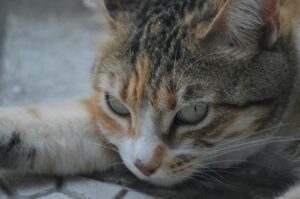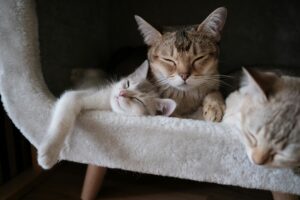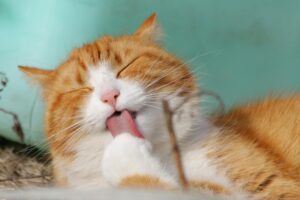The Khao Manee cat is a rare and regal breed, known for its gleaming white coat and piercing eyes that can be blue, gold, or even odd-colored. But beauty isn’t the only trait that defines this Thai treasure—like all felines.
As their health and longevity largely depend on proper nutrition. That’s where understanding the right Khao Manee food becomes essential.
Feeding your Khao Manee isn’t just about keeping their stomach full. It’s about fueling their high-energy lifestyle, preserving their brilliant coat, supporting immune function, and preventing breed-specific health issues.
Whether you’re a first-time Khao Manee owner or simply want to refine your cat’s diet, this guide has everything you need to know.
Why Choosing the Right Khao Manee Food Matters
A cat’s diet plays a pivotal role in its health and happiness, and the Khao Manee is no exception. As an active, intelligent, and social breed, they require a diet that supports their unique physical and mental needs.
Here’s why feeding the right food is so important:
- Supports energy needs: Khao Manees are playful and energetic.
- Maintains coat health: Their white fur is prone to dullness if poorly fed.
- Strengthens immunity: A balanced diet prevents common feline illnesses.
- Prevents obesity: Despite their slim appearance, they can gain weight quickly without portion control.
- Promotes longevity: Proper nutrition can extend their lifespan to 16 years or more.
Nutritional Needs of Khao Manee Cats
To determine the best Khao Manee food, we first need to understand their nutritional requirements.
1. High-Quality Protein
Cats are obligate carnivores, and protein is the cornerstone of their diet. Khao Manees need a high-protein diet to support muscle development and daily energy needs.
- Look for food with meat as the first ingredient (e.g., chicken, turkey, lamb, or fish).
- Avoid foods where the primary protein comes from plant sources.
2. Healthy Fats
Fats provide energy and help absorb fat-soluble vitamins. Omega-3 and Omega-6 fatty acids are especially important for the Khao Manee’s coat and skin.
- Look for sources like salmon oil, chicken fat, or flaxseed oil.
- Ensure the food contains linoleic acid for skin health.
3. Vitamins and Minerals
Balanced commercial cat food should include:
- Vitamin A & E for immunity and vision
- Taurine, an essential amino acid for heart and eye health
- Calcium & phosphorus for strong bones
- Zinc and biotin for coat health
4. Low Carbohydrates
Too many carbs can lead to weight gain and blood sugar issues.
- Choose foods with less than 30% carbohydrates.
- Avoid fillers like corn, wheat, and soy.
Best Types of Khao Manee Food
Let’s break down the types of food available for your Khao Manee and discuss the pros and cons of each.
1. Dry Food (Kibble)
Pros:
- Convenient and easy to store
- Helps with dental health through chewing
- Long shelf life
Cons:
- Lower moisture content
- Some brands contain fillers and artificial additives
Recommendation: Choose grain-free, protein-rich dry kibble formulated for active adult cats or kittens (depending on your pet’s age).
2. Wet Food (Canned)
Pros:
- High moisture content (prevents dehydration and urinary issues)
- Often more palatable to picky eaters
Cons:
- More expensive
- Needs refrigeration after opening
Best For: Cats with urinary problems, low water intake, or poor appetite.
3. Raw Food Diet
Pros:
- Mimics ancestral feline diet
- High in natural protein
Cons:
- Risk of bacterial contamination (e.g., Salmonella, E. coli)
- Requires careful handling and balance of nutrients
Tip: If you opt for raw food, consult a veterinary nutritionist to ensure your cat receives all essential vitamins and minerals.
4. Homemade Food
Pros:
- Complete control over ingredients
- Avoids preservatives and allergens
Cons:
- Time-consuming to prepare
- Nutritional imbalances are common without guidance
Suggestion: Use only vet-approved recipes. Homemade food must include taurine, calcium, and vitamin supplementation.
Khao Manee Food for Kittens
A Khao Manee kitten has different dietary needs than an adult cat. Their rapid growth and high energy levels demand food with:
- Extra protein and calories
- More calcium and phosphorus for bone growth
- DHA and EPA for brain and vision development
Best Practice:
- Feed kitten-formulated food until 12 months of age.
- Offer meals 3–4 times daily.
- Introduce a mix of wet and dry food for variety and hydration.
Top brands for Khao Manee kittens include:
- Royal Canin Mother & Babycat
- Wellness CORE Kitten
- Hill’s Science Diet Kitten
Feeding Guidelines for Adult Khao Manee Cats
As your Khao Manee matures, maintaining an ideal weight becomes the top priority.
Portion Sizes
- Follow the feeding guide on the packaging (usually based on weight and age).
- Adult Khao Manees generally need 200-250 calories per day.
- Split the food into 2 meals per day to prevent overeating.
Monitor Weight
- Run your hand along their sides; you should feel ribs without pressing hard.
- Watch for changes in activity or coat texture—they can signal dietary issues.
Water Intake
- Encourage drinking by using a cat water fountain.
- Always pair dry food with accessible fresh water.
Senior Khao Manee Food Requirements
Senior cats (10 years and older) may need food that supports:
- Joint health (glucosamine and chondroitin)
- Kidney function (lower phosphorus and sodium)
- Weight management
Choose senior-formula cat food from trusted brands like:
- Blue Buffalo Healthy Aging
- Royal Canin Aging 12+
- Hill’s Science Diet Senior
Consult your vet for bloodwork to assess kidney and liver health, which may influence dietary recommendations.
Common Feeding Mistakes to Avoid
Feeding your Khao Manee the wrong way can cause long-term health issues. Avoid these common errors:
❌ Overfeeding
Khao Manees are agile but can gain weight if overfed or under-exercised. Use a kitchen scale or measuring cup for precision.
❌ Giving Human Food
Avoid sharing:
- Onions, garlic (toxic to cats)
- Chocolate, caffeine
- Bones, dairy, alcohol
❌ Inconsistent Meal Times
Establish a routine. Free feeding leads to obesity and picky behavior.
❌ Not Switching Diets Gradually
When transitioning to a new food, mix it with the old food over 7–10 days to avoid digestive upset.
Best Brands for Khao Manee Food
Here are some high-quality commercial food brands that suit the nutritional needs of Khao Manee cats:
| Brand | Type | Why It’s Good |
|---|---|---|
| Orijen Cat & Kitten | Dry | High protein, grain-free |
| Wellness CORE Grain-Free | Dry/Wet | Balanced nutrition, no fillers |
| Tiki Cat | Wet | Moisture-rich, real meat |
| Instinct Raw Boost | Raw-infused dry | Combines kibble and freeze-dried raw |
| Royal Canin Indoor | Dry | Digestive support and coat health |
Khao Manee Food for Special Needs
Some Khao Manees may have unique dietary requirements due to allergies, sensitivities, or health conditions.
Allergies
Signs: Skin irritation, excessive grooming, vomiting, or diarrhea. Solution: Switch to hypoallergenic food (e.g., hydrolyzed protein diets like Royal Canin Hypoallergenic).
Sensitive Stomachs
Look for food with easily digestible proteins, prebiotics, and no artificial additives.
Urinary Issues
Choose food that:
- Promotes urinary pH balance
- Controls magnesium and phosphorus levels (e.g., Hill’s Prescription Diet c/d Multicare)
Always consult your veterinarian if your cat shows persistent health issues.
How to Improve Your Khao Manee’s Eating Habits
Feeding time is not just about nutrition—it’s a bonding opportunity.
- Use interactive feeders or puzzle bowls to engage their intelligence.
- Keep feeding areas clean and quiet.
- Avoid metal or plastic bowls if they cause skin irritation; use ceramic or stainless steel.
- Monitor stool and urine regularly for changes in health.
Final Thoughts on Khao Manee Food
Feeding your Khao Manee cat the right food is crucial to supporting their unique beauty, boundless energy, and long life.
Whether you’re raising a kitten or caring for a senior, understanding their dietary needs ensures you’re providing the best care possible.
To summarize:
- Opt for high-protein, low-carb diets with minimal fillers.
- Mix wet and dry food for balanced nutrition and hydration.
- Choose reputable grain-free or limited-ingredient brands.
- Adjust food type and quantity with age and health status.
- Always provide fresh water and maintain a feeding routine.
With the right nutrition, your Khao Manee will thrive—radiating health, happiness, and elegance for many years.


